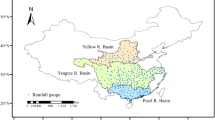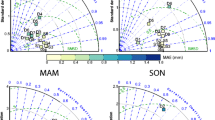Abstract
Statistical downscaling is a technique widely used to overcome the spatial resolution problem of General Circulation Models (GCMs). Nevertheless, the evaluation of uncertainties linked with downscaled temperature and precipitation variables is essential to climate impact studies. This paper shows the potential of a statistical downscaling technique (in this case SDSM) using predictors from three different GCMs (GCGM3, GFDL and MRI) over a highly heterogeneous area in the central Andes. Biases in median and variance are estimated for downscaled temperature and precipitation using robust statistical tests, respectively Mann–Whitney and Brown–Forsythe's tests. In addition, the ability of the downscaled variables to reproduce extreme events is tested using a frequency analysis. Results show that uncertainties in downscaled precipitations are high and that simulated precipitation variables failed to reproduce extreme events accurately. Nevertheless, a greater confidence remains in downscaled temperatures variables for the area. GCMs performed differently for temperature and precipitation as well as for the different test. In general, this study shows that statistical downscaling is able to simulate with accuracy temperature variables. More inhomogeneities are detected for precipitation variables. This first attempt to test uncertainties of statistical downscaling techniques in the heterogeneous arid central Andes contributes therefore to an improvement of the quality of predictions of climate impact studies in this area.






Similar content being viewed by others
References
Aceituno P (1988) On the functioning of the southern oscillation in the south american sector. Part I: surface climate. Mon Weather Rev 116(3):505–524
Barnston AG, He Y, Glantz MH (1999) Predictive skill of statistical and dynamical climate models in sst forecasts during the 1997–98 El Niño episode and the 1998 La Niña onset. Bull Am Meteorol Soc 80(2):217–243
Biondi F, Gershunov A, Cayan DR (2001) North Pacific decadal climate variability since 1661. J Climate 14:5–10
Blöschl G, Montanari A (2010) Climate change impacts—throwing the dice? Hydrolog Process 24(3):374–381
Boe J, Terray L, Habets F, Martin E (2007) Statistical and dynamical downscaling of the seine basin climate for hydro-meteorological studies. Int J Climatol 27(12):1643–1655
Brown MB, Forsythe AB (1974) Robust tests for the equality of variances. J Am Stat Assoc 69:364–367
Chu J, Xia J, Xu CY, Singh V (2010) Statistical downscaling of daily mean temperature, pan evaporation and precipitation for climate change scenarios in Haihe River, China. Theor Appl Climatol 99(1):149–161
Conover WJ, Johnson ME, Johnson MM (1981) A comparative study of tests for homogeneity of variance with applications to the outer continental shelf bidding data. Technometrics 23:351–361
Delworth TL, Broccoli AJ, Rosati A, Stouffer RJ, Balaji V, Beesley JA, Cooke WF, Dixon KW, Dunne J, Dunne KA, Durachta JW, Findell KL, Ginoux P, Gnanadesikan A, Gordon CT, Griffies SM, Gudgel R, Harrison MJ, Held IM, Hemler RS, Horowitz LW, Klein SA, Knutson TR, Kushner PJ, Langenhorst AR, Lee H-C, Lin S-J, Lu J, Malyshev SL, Milly PCD, Ramaswamy V, Russell J, Schwarzkopf MD, Shevliakova E, Sirutis JJ, Spelman MJ, Stern WF, Winton M, Wittenberg AT, Wyman B, Zeng F, Zhang R (2006) GFDL's CM2 global coupled climate models. Part I: formulation and simulation characteristics. J Climate 19(5):643–674
Diaz-Nieto J, Wilby RL (2005) A comparison of statistical downscaling and climate change factor methods: impacts on low flows in the River Thames, United Kingdom. Climatic Change 69(2):245–268
Dibike YB, Gachon P, St-Hilaire A, Ouarda T, Nguyen VTV (2008) Uncertainty analysis of statistically downscaled temperature and precipitation regimes in Northern Canada. Theor Appl Climatol 91(1–4):149–170
Doblas-Reyes FJ, Pavan V, Stephenson DB (2003) The skill of multi-model seasonal forecasts of the wintertime North Atlantic Oscillation. Clim Dynam 21(5):501–514
Downing ET, Santibánez F, Romero H, Pena HT, Gwynne RN, Ihl M, Rivera A (1994) Climate change and sustainable development in the Norte Chico, Chile: climate, water resources and agriculture. Environmental Change Unit Research Report No. 6. University of Oxford, Oxford
Dregne HE (1985) Aridity and land degradation. Environment 27(8):16–20
Favier V, Falvey M, Rabatel A, Praderio E, Lopez D (2009) Interpreting discrepancies between discharge and precipitation in high-altitude area of Chile's Norte Chico region (26–32°s). Water Resour Res 45 (W02424). doi:10.1029/2008WR006802
Flato GM, Boer GJ (2001) Warming asymmetry in climate change simulations. Geophys Res Lett 28(1):195–198
Garreaud RD, Vuille M, Compagnucci R, Marengo J (2009) Present-day South American climate. Palaeogeogr Palaeoclimatol Palaeoecol 281(3–4):180–195
Giorgi F, Mearns LO (1991) Approaches to the simulation of regional climate change: a review. Rev Geophys 29:191–216
Giorgi F, Mearns LO (2002) Calculation of average, uncertainty range, and reliability of regional climate changes from aogcm simulations via the reliability ensemble averaging (REA) method. J Clim 15(10):1141–1158. doi:10.1175/1520-0442(2002)015<1141:COAURA>2.0.CO;2
Greene AM, Goddard L, Lall U (2006) Probabilistic multimodel regional temperature change projections. J Clim 19(17):4326–4343
Helsel DR, Hirsch RM (2002) Statistical methods in water resources. Elsevier, Amsterdam
Holmgren M, Stapp P, Dickman CR, Gracia C, Graham S, Gutierrez JR, Hice C, Jaksic F, Kelt DA, Letnic M, Lima M, Lopez BC, Meserve PL, Milstead WB, Polis GA, Previtali MA, Richter M, Sabate S, Squeo FA (2006) Extreme climatic events shape arid and semiarid ecosystems. Front Ecol Environ 4(2):87–95. doi:10.1890/1540-9295(2006)004[0087:ECESAA]2.0.CO;2
Hostetler SW (1994) Hydrologic and atmospheric models: the (continuing) problem of discordant scales. Climatic Change 27(4):345–350
IPCC (2007) Climate change 2007: the physical science basis. Contribution of Working Group I to the fourth assessment report of the intergovernmental panel on climate change. Cambridge University Press, Cambridge, United Kingdom and New York, NY, USA
Kalnay E, Kanamitsu M, Kistler R, Collins W, Deaven D, Gandin L, Iredell M, Saha S, White G, Woollen J, Zhu Y, Leetmaa A, Reynolds R, Chelliah M, Ebisuzaki W, Higgins W, Janowiak J, Mo KC, Ropelewski C, Wang J, Jenne R, Joseph D (1996) The NCEP-NCAR 40-year reanalysis project. Bull Am Meteorol Soc 77(3):437–471
Kalthoff N, Bischoff G, Inge Fiebig-Wittmaack M, Fiedler F, Thrauf J, Novoa E, Pizarro C, Castillo R, Gallardo L, Rondanelli R, Kohler M (2002) Mesoscale wind regimes in Chile at 30°s. J Appl Meteorol 41(9):953–970
Khan MS, Coulibaly P, Dibike Y (2006) Uncertainty analysis of statistical downscaling methods using Canadian global climate model predictors. Hydrolog Process 20(14):3085–3104
Kim J, Miller NL, Farrara JD, Hong S-Y (2000) A seasonal precipitation and stream flow hindcast and prediction study in the western United States during the 1997/98 winter season using a dynamic downscaling system. J Hydrometeorol 1(4):311–329
Kistler R, Kalnay E, Collins W, Saha S, White G, Woollen J, Chelliah M, Ebisuzaki W, Kanamitsu M, Kousky V, van den Dool H, Jenne R, Fiorino M (2001) The NCEP-NCAR 50-year reanalysis: monthly means CD-ROM and documentation. Bull Am Meteorol Soc 82(2):247–267
Kundzewicz ZW, Mata LJ, Arnell NW, Döll P, Jimenez B, Miller K, Oki T, Şen Z, Shiklomanov I (2008) The implications of projected climate change for freshwater resources and their management. Hydrol Sci J 53(1):3–10
Labraga J (2010) Statistical downscaling estimation of recent rainfall trends in the eastern slope of the Andes mountain range in Argentina. Theor Appl Climatol 99(3):287–302
Laux P, Wagner S, Wagner A, Jacobeit J, Bárdossy A, Kunstmann H (2009) Modelling daily precipitation features in the Volta Basin of West Africa. Int J Climatol 29(7):937–954
Levene H (1960) Robust tests for the equality of variances. In: Olkin I, Ghurye S, Hoeffding W, Madow WG, Mann HB (eds) Contribution to probability and statistics. Stanford University Press, Palo Alto
Lopez A, Tebaldi C, New M, Stainforth D, Allen M, Kettleborough J (2006) Two approaches to quantifying uncertainty in global temperature changes. J Climate 19(19):4785–4796. doi:10.1175/JCLI3895.1
Mann HB, Whitney DR (1947) On a test of whether one of two random variables is stochastically larger than the other. Ann Math Stat 18:50–60
Marengo JA, Jones R, Alves LM, Valverde MC (2009) Future change of temperature and precipitation extremes in South America as derived from the PRECIS regional climate modeling system. Int J Climatol 29:2241–2255
Mata LJ, Campos M (2001) Latin america. In: McCarthy JJ, Canziani OF, Leary NA, Dokken DJ, White KS (eds) Climate change 2001: impacts, adaptation, and vulnerability. Contribution of Working Group II to the third assessment report of the intergovernmental panel on climate change. University Press, Cambridge, pp 693–734
Mearns LO, Easterling W, Hays C, Marx D (2001) Comparison of agricultural impacts of climate change calculated from high and low resolution climate change scenarios: part I. The uncertainty due to spatial scale. Climatic Change 51(2):131–172
Messerli B, Grosjean M, Graf K, Schotterer U, Schreier H, Vuille M (1992) Die veränderungen von klima und umwelt in der region acatama (chile) seit der letzten kaltzeit. Erdkunde 46(3/4):257–272
Miller A (1976) The climate of Chile. In: Schwerdfeger W (ed) World survey of climatology: climates of Central and South America. Elsevier, Amsterdam, pp 113–145
Penlap EK, Matulla C, von Storch H, Kamga FM (2004) Downscaling of GCM scenarios to assess precipitation changes in the little rainy season (March–June) in Cameroon. Clim Res 26(2):85–96
Pouyaud B, Zapata M, Yerren J, Gomez J, Rosas G, Suarez W, Ribstein P (2005) Avenir des ressources en eau glaciaire de la cordillère blanche. Hydrol Sci J 50(6):999–1022
Rojas M (2006) Multiply nested regional climate simulation for southern South America: sensitivity to model resolution. Mon Weather Rev 134(8):2208–2223
Singh P, Arora M, Goel NK (2006) Effect of climate change on runoff of a glacierized Himalayan Basin. Hydrolog Process 20:1979–1992
Solman SA, Nunez MN (1999) Local estimates of global climate change: a statistical downscaling approach. Int J Climatol 19:835–861
Souvignet M, Gaese H, Ribbe L, Kretschmer N, Oyarzún R (2010) Statistical downscaling of precipitation and temperature in north-central Chile: an assessment of possible climate change impacts in an arid Andean watershed. Hydrol Sci J 56(1):41–57
Souvignet M, Oyarzún R, Verbist KMJ, Gaese H, Heinrich J (2011) Trends in hydro-meteorological extremes in semi-arid North-Central Chile (20–32°s): water resources implications for a fragile Andean region. Hydrolog Sci J (in press)
Verbist K, Robertson AW, Cornelis WM, Gabriels D (2010) Seasonal predictability of daily rainfall characteristics in central northern Chile for dry-land management. J Appl Meteorol Clim 49(9):1938–1955. doi:10.1175/2010JAMC2372.1
Wetterhall F, Bárdossy A, Chen D, Halldin S, Xu C-Y (2006) Daily precipitation-downscaling techniques in three Chinese regions. Water Resour Res 42(11):13. doi:10.1029/2005WR004573
Wetterhall F, Halldin S, Xu CY (2007) Seasonality properties of four statistical-downscaling methods in central Sweden. Theor Appl Climatol 87(1–4):123–137
Wilby RL, Charles SP, Zorita E, Timbal B, Whetton P, Mearns LO (2004) Guidelines for use of climate scenarios developed from statistical downscaling methods. Supporting material of the Intergovernmental Panel on Climate Change. Available from the DDC of IPCC TGCIA, 27pp.
Wilby RL, Dawson CW, Barrow EM (2002) SDSM—a decision support tool for the assessment of regional climate change impacts. Environ Model Software 17(2):145–157
Wood AW, Maurer EP, Kumar A, Lettenmaier DP (2002) Long-range experimental hydrologic forecasting for the eastern United States. J Geophys Res 107(D20):4429. doi:10.1029/2001JD000659
Yukimoto S, Noda A, Kitoh A, Sugi M, Kitamura Y, Hosaka M, Shibata K, Maeda S, Uchiyama T (2001) The new Meteorological Research Institute coupled GCM (MRI-CGCM2). Model climate and variability. Pap Meteorol Geophys 51:47–88
Acknowledgments
The authors express also their gratitude to the DGA for providing the meteorological variables used in this study. We acknowledge the modelling groups for making their model output available for analysis, and the Program for Climate Model Diagnosis and Inter-comparison for collecting and archiving this data. In addition, the authors would like to thank the IRI for providing access to its data library. SDSM was supplied by Robert Wilby and Christian Dawson on behalf of the Environment Agency of Wales. Finally, we would like to acknowledge one anonymous reviewer for his constructive comments, which greatly helped in improving our original manuscript.
Author information
Authors and Affiliations
Corresponding author
Rights and permissions
About this article
Cite this article
Souvignet, M., Heinrich, J. Statistical downscaling in the arid central Andes: uncertainty analysis of multi-model simulated temperature and precipitation. Theor Appl Climatol 106, 229–244 (2011). https://doi.org/10.1007/s00704-011-0430-z
Received:
Accepted:
Published:
Issue Date:
DOI: https://doi.org/10.1007/s00704-011-0430-z




